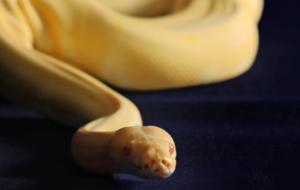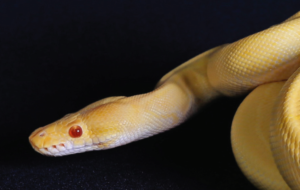The Royal Ball
Since they’ve proven to be popular, let’s revisit the ball python or Python regius, which is the most commonly kept snake in the world. They are relatively compact, available in many pet stores and breeders, and are fairly simple to care for. Also known as the ‘Royal Python’ in Europe, the ball python is native to central and western Africa, and thrive in warm, tropical environments.
Ball python hatchlings are around 10 inches in length. Adult females grow to about 3-5 feet long, and adult males average 2-3 feet. This is one species where the females are definitely the more dangerous sex! Born to be Tame When selecting a ball python to take home, look for captive born and bred snakes. Wild-caught ball pythons are usually adults or sub-adults and may have ticks. Wild pythons are also some of the most difficult creatures to feed, since their natural prey is gerbils, which can be expensive. Wild pythons will sometimes refuse to eat mice, even when starving.
In contrast, captive-born and bred ball pythons are docile, and easy to care for. They have a high tolerance for being handled, and their potential for selective breeding have made them very popular, leading to new ‘morphs’ appearing almost one a month. And that’s the hot topic these days: ball python morphs. Morphin’ Time Thanks to today’s intrepid breeders, ball python morphs come in a dizzying array of colors and patterns, such as axanthic, clown, labyrinth, jungle, tiger, spider, ghost, piebald, albino, striped, and many, many others.

So What is a Morph, Exactly?
We asked our resident expert Pitlair, who explained that the first requirement for a ball python to be considered a morph is that it must look significantly and distinctly different from the wild type, otherwise known as a ‘Normal’ within the community. Next, that distinctly different appearance must be an inheritable trait, meaning that it should be capable of being passed down from one generation to another. Like all genetics, this involves quite a bit of probability and math. Dominant morphs, such as spider or pinstripe morphs, will produce the same looks whether the snake inherits it from one or both of its parents. Co-dominants, such as pastel or Mojave, will have one appearance when a single mutated gene is present, and another appearance the snake receives a matched pair from its parents.
Finally, many morph are Recessive, which means they must have a matched gene pair from both parents in order to produce a visual difference in its appearance. Piebalds (which were featured in a recent Animal Scene issue), albinos, and axanthics are good examples of recessive morphs.
Game of Morph
Before breeding, make sure that the pair are the correct age and weight. It takes 1.5 years and up for males to become sexually active, and females two and a half years at least, although Pitlair says three years is ideal. The females also need to weigh at least 1.5kg and in good health.
Still, Pitlair emphasizes, creating or recreating morphs is very much a game of luck. “When the season is right, you simply put them together and let nature take its course. Pairing them together does not guarantee that you will get eggs, or that you will get good eggs. If you get bad eggs, you will need to wait another year to try again next season.”
In case you are lucky enough to produce a viable clutch of eggs, incubation will take 2 months. “Like all parents, we always hope for healthy babies. If everything runs smoothly, you should be able to create your desired combination in three years.”
He adds, “In a sense, we aren’t able to create morphs ourselves. Only Mother Nature can create morphs.” He cautions against simply “winging it” when first learning how to raise and breed morphs.
“Breeding ball pythons is not difficult, but getting enough correct information will make for successful breeding and fewer complications. Inexperience and overzealousness is a bad combination. One of the worst cases that can occur is if the female becomes egg bound, and the keeper doesn’t know what is happening or how to handle the situation. This can lead to health issues and even death.”

Eggward Bound
What does ‘egg bound’ mean? It’s not a clever pun; instead, it refers to when female reptiles are unable to pass an egg that has already formed inside her. This condition is known as ‘egg binding’. Female egg-laying reptiles such as snakes can produce eggs even without a male present, so all females are at risk of being egg bound.
Females that are egg bound often act restless and constantly try to find digging spots. Their cloaca – the common chamber where the intestinal and urogenital tracts empty – may be swollen, and the snake might be constantly straining. Eventually, the reptile may become lethargic and depressed, with tissue protruding from the cloaca. This could lead to health problems and even death.
Sometimes, simply providing a suitably heated and humidified nesting site for the female can stimulate the passing of eggs. In other cases, massage or hormone injections to stimulate labor may be necessary. Finally, surgical removal or collapsing the eggs with a syringe can be performed to save the mother’s life.

Caring for Morphs
The care of morphs is just like the care of any other ball python, says Pitlair. These snakes require either a terrarium or a rack system with a warm side and a cool side to help them regulate their body temperature, since snakes are cold-blooded. They also need a hiding place on both side to help them feel safe.
Morphs, like all ball pythons, are relatively clean creatures and can live in most beddings or substrates, even newspapers. Cedar shavings are not good beddings for snakes, however, as the volatile oils within the shavings can cause skin, respiratory, and reproductive system damage. Also, avoid collecting your substrates from the wild, as they may contain organisms that are harmful to your morph.
This appeared as “More on the Morph” in Animal Scene’s January 2016 issue.






